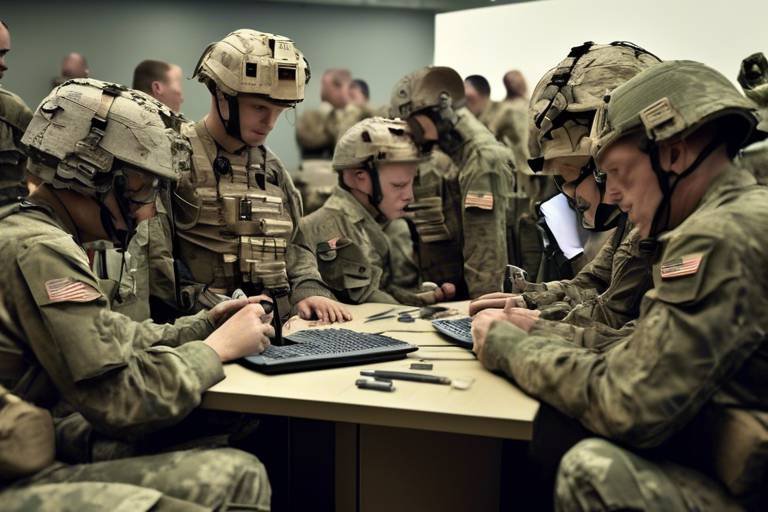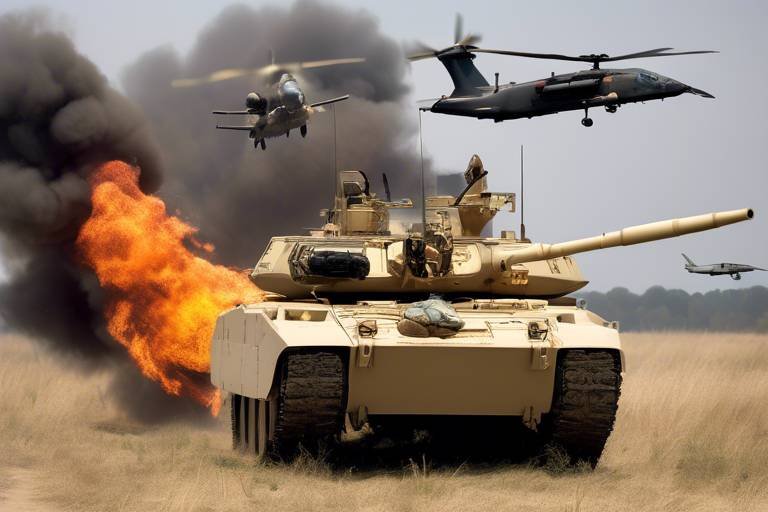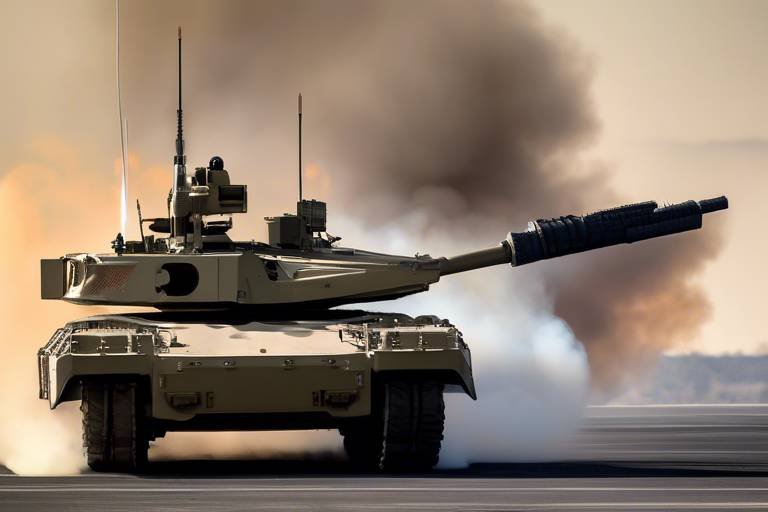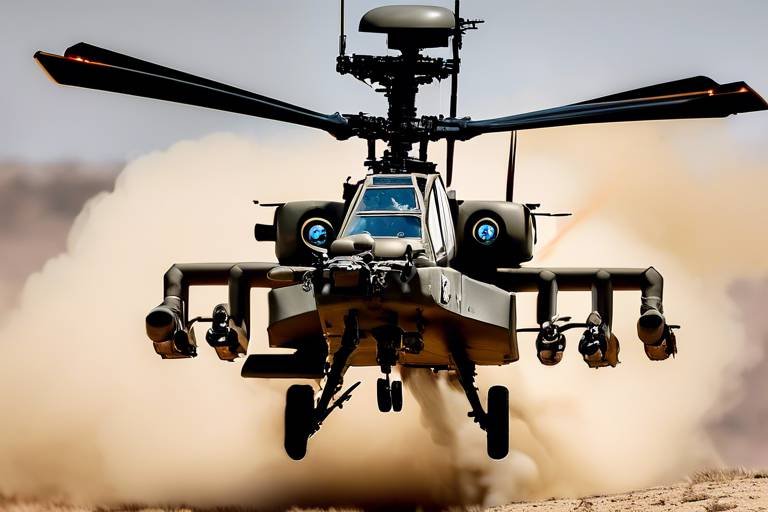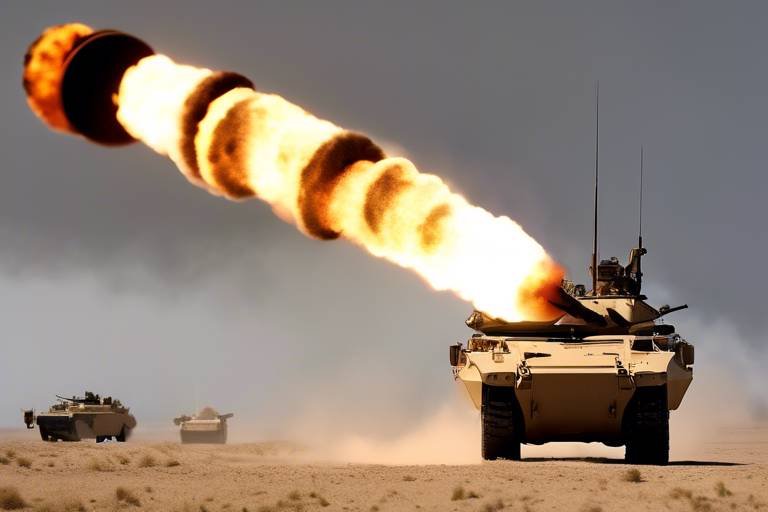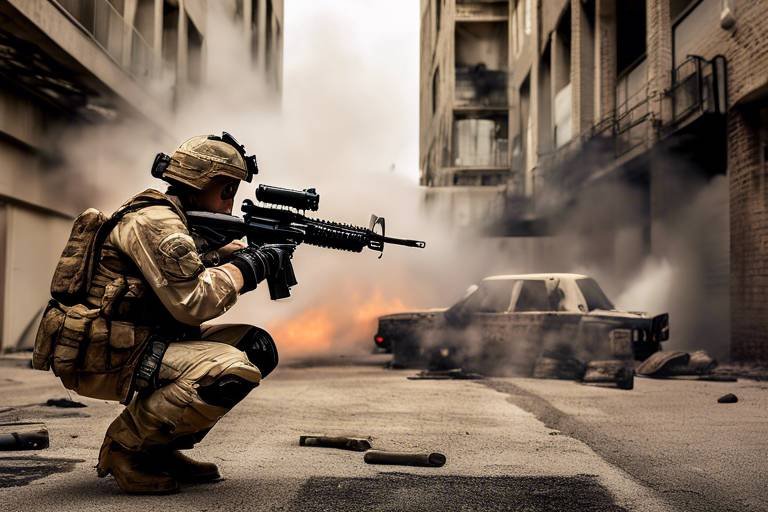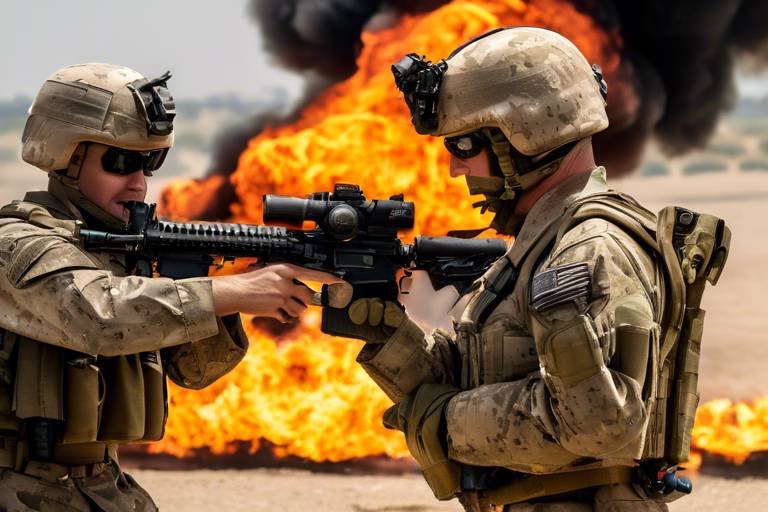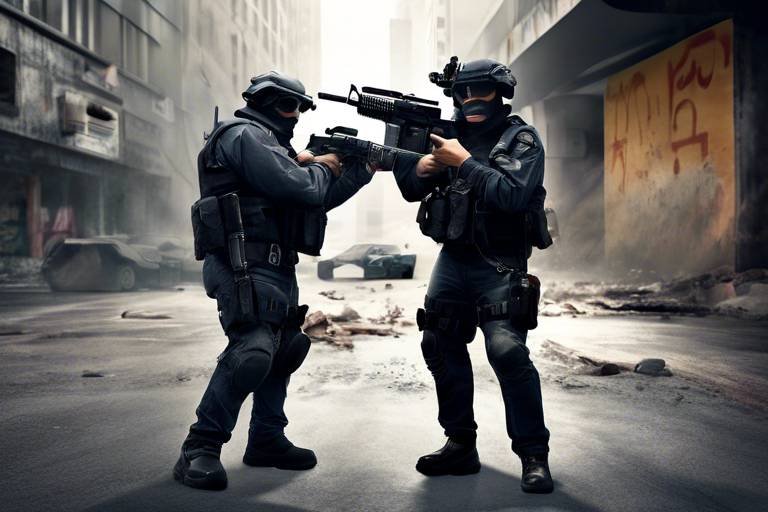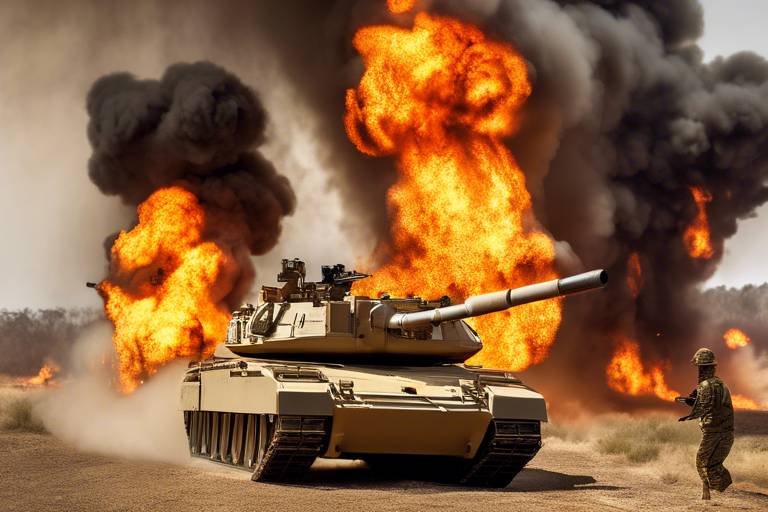The Impact of Technological Innovations on Military Strategy
In an era where the landscape of warfare is constantly evolving, technological innovations have emerged as the driving force behind military strategy transformations. From the days of ancient warfare, where brute strength and tactics ruled the battlefield, to the modern age characterized by precision and intelligence, technology has played a pivotal role in shaping how nations approach conflict. These advancements not only enhance operational efficiency but also alter the very dynamics of combat, influencing global power structures in profound ways.
Imagine a battlefield where decisions are made in real-time, guided by data analytics and artificial intelligence. This is not a distant future—this is the present. Innovations such as unmanned aerial vehicles (UAVs), advanced surveillance systems, and cyber capabilities have redefined traditional military operations. The integration of these technologies allows for quicker, more informed decisions, enabling forces to adapt to rapidly changing scenarios. As we delve deeper into this topic, we will explore key innovations that have emerged over the years, their implications for modern warfare, and how they are reshaping military strategies worldwide.
One of the most striking aspects of this technological transformation is the shift from conventional warfare to a more hybrid approach. Hybrid warfare combines conventional military tactics with irregular tactics, cyber warfare, and information warfare. This blend of strategies requires military leaders to be not only tacticians but also tech-savvy individuals who can leverage the latest innovations to gain an edge over adversaries. For instance, the use of artificial intelligence in analyzing data from various sources allows commanders to anticipate enemy movements and deploy resources more effectively.
Furthermore, the rise of cyber warfare has introduced a new dimension to military strategy. Cyber capabilities can disrupt critical infrastructure, steal sensitive information, and even manipulate public perception. The implications of this are staggering, as nations must now consider not only their physical borders but also their digital ones. The integration of these technologies into military doctrine is not merely an enhancement; it is a necessity in today's interconnected world.
As we explore the intricate relationship between technology and military strategy, it becomes clear that understanding this evolution is crucial for both military professionals and policymakers. The stakes are high, and those who fail to adapt risk falling behind in an increasingly competitive global landscape. So, what does the future hold for military strategy in light of these technological innovations? Let's dive deeper into the evolution of warfare technology and uncover the pivotal innovations that have shaped, and will continue to shape, military tactics and strategies.
- What are some key technological innovations in military strategy? Innovations like UAVs, cyber capabilities, and AI-driven analytics have significantly transformed military operations.
- How has cyber warfare changed military tactics? Cyber warfare introduces new methods of attack and defense, making digital security as crucial as physical security.
- What role does data analytics play in modern military operations? Data analytics enhances decision-making, resource allocation, and battlefield effectiveness by providing real-time insights.
- Are autonomous weapons systems ethical? The use of autonomous weapons raises significant ethical concerns regarding accountability and decision-making in combat.
Evolution of Warfare Technology
The landscape of warfare has undergone a profound transformation over the centuries, driven largely by technological innovations. From the earliest days of human conflict, where brute strength and rudimentary tools dictated the outcome of battles, we have witnessed a remarkable evolution. Imagine a time when the invention of gunpowder revolutionized warfare, enabling armies to unleash devastating firepower that could change the tide of a conflict in an instant. This pivotal moment marked the beginning of a new era in military strategy, where technology began to play a crucial role in shaping tactics and outcomes.
As we move through history, we encounter significant advancements such as the introduction of the rifle, which provided soldiers with greater range and accuracy compared to traditional muskets. This shift not only altered the dynamics of battlefield engagements but also necessitated new strategies for troop formations and maneuvers. The advent of artillery further escalated the scale of destruction, allowing armies to bombard enemy positions from a distance, thereby changing the way wars were fought.
Fast forward to the 20th century, and we see the emergence of mechanized warfare. The introduction of tanks and armored vehicles during World War I and II redefined ground combat, making traditional infantry tactics obsolete. This shift was accompanied by the development of air power, where aircraft began to play a pivotal role in reconnaissance and bombing missions, providing a strategic advantage that ground forces could not achieve alone.
In recent decades, the rise of the digital age has brought about another seismic shift in military technology. The integration of information technology into military operations has led to the development of advanced communication systems, satellite navigation, and precision-guided munitions. These innovations have enhanced operational efficiency and allowed for more precise strikes, minimizing collateral damage while maximizing effectiveness. The ability to gather and analyze real-time data has become a game changer, enabling commanders to make informed decisions on the fly.
Moreover, the emergence of cyber warfare has introduced a new dimension to military strategy. As nations increasingly rely on digital infrastructure, the battlefield has expanded beyond physical locations to include virtual spaces. This evolution presents both opportunities and challenges, as military forces must now defend against cyber threats while also leveraging offensive capabilities in the digital realm.
In summary, the evolution of warfare technology has been marked by a series of groundbreaking innovations that have continuously reshaped military strategies. From the invention of gunpowder to the rise of cyber warfare, each advancement has altered the way conflicts are conducted and has had lasting implications for global power dynamics. Understanding this evolution is crucial for grasping the complexities of modern warfare and the strategies employed by nations around the world.
- What was the most significant technological advancement in warfare history?
The invention of gunpowder is often regarded as one of the most significant advancements, as it transformed military tactics and strategies. - How has cyber warfare changed traditional military operations?
Cyber warfare has expanded the battlefield into the digital realm, requiring military forces to adapt their strategies to defend against and engage in cyber threats. - What role does data analytics play in modern military strategy?
Data analytics enhances decision-making processes by providing real-time intelligence and predictive insights, allowing for more effective resource allocation and strategic planning.
Cyber Warfare and Its Implications
In today's interconnected world, cyber warfare has emerged as a formidable component of military strategy, fundamentally altering how conflicts are initiated and conducted. Unlike traditional warfare, which often involves physical confrontations, cyber warfare engages adversaries in the digital realm, targeting critical infrastructure, government systems, and even civilian networks. This shift not only challenges conventional military operations but also raises pressing questions about national security and the ethical dimensions of warfare.
The significance of cyber warfare cannot be overstated. It allows state and non-state actors to execute operations that can disrupt economies, compromise sensitive information, and create chaos without the need for boots on the ground. For example, consider the infamous Stuxnet attack on Iran's nuclear facilities, which demonstrated how a well-crafted cyber operation could achieve strategic objectives without direct military engagement. Such incidents highlight the need for nations to adapt their military strategies to incorporate cyber capabilities, as the battlefield has expanded into the digital domain.
Moreover, the methods employed in cyber warfare are as diverse as they are sophisticated. From phishing attacks designed to harvest credentials to advanced persistent threats (APTs) that infiltrate networks over long periods, the tactics used by cyber warriors are constantly evolving. Nations must not only defend against these threats but also develop offensive capabilities to deter adversaries. This duality of cyber operations creates a complex landscape where the lines between defense and offense blur, prompting military leaders to rethink their approach to conflict.
However, the rise of cyber warfare comes with significant challenges. One of the most pressing issues is the vulnerability of critical infrastructure. As more systems become interconnected, the potential impact of a successful cyber attack increases exponentially. For instance, a breach in a power grid could lead to widespread blackouts, affecting hospitals, transportation systems, and emergency services. This interconnectedness necessitates a robust response strategy, emphasizing the importance of cybersecurity measures across all sectors.
Furthermore, the legal and ethical implications of cyber warfare are still being debated. Questions arise about the rules of engagement in cyberspace: How do we define an act of war in the digital realm? What are the responsibilities of states to protect their citizens from cyber threats? These are crucial considerations that military strategists and policymakers must address as they navigate this new frontier.
In conclusion, as cyber warfare continues to evolve, it will undoubtedly shape the future of military strategy. Nations must invest in developing comprehensive cyber capabilities, both defensive and offensive, to safeguard their interests and maintain a competitive edge. The implications of cyber warfare extend beyond military circles; they impact global politics, economics, and societal norms, making it imperative for all stakeholders to engage in a dialogue about the future of conflict in the digital age.
- What is cyber warfare? Cyber warfare refers to the use of digital attacks by one nation to disrupt the vital computer systems of another, often targeting critical infrastructure and sensitive data.
- How does cyber warfare differ from traditional warfare? Unlike traditional warfare, which involves physical battles, cyber warfare takes place in the digital realm, allowing for remote attacks that can be executed without direct confrontation.
- What are the risks associated with cyber warfare? Risks include the potential for widespread disruption of essential services, loss of sensitive information, and escalation of conflicts without physical engagement.
- How can nations protect themselves from cyber warfare? Nations can enhance their cybersecurity measures, invest in technology, and develop international agreements to mitigate the risks and consequences of cyber attacks.
Cybersecurity Measures
As we plunge deeper into the digital age, the battlefield has expanded beyond the physical realm and into the intricate world of cyberspace. This shift has made more crucial than ever for military organizations worldwide. Protecting sensitive information and communication channels is no longer just a precaution; it's a necessity. With the rise of cyber threats, military forces must adopt a multi-layered approach to defend against potential breaches and attacks.
One of the primary strategies in enhancing cybersecurity is the implementation of robust encryption protocols. Encryption acts as a shield, ensuring that even if data is intercepted, it remains unreadable to unauthorized users. This is particularly vital for communication between military units, where the confidentiality of operational details can mean the difference between success and failure on the field. Moreover, encryption is not just limited to communication; it also extends to data storage, ensuring that sensitive information remains protected even when at rest.
Another key element of cybersecurity measures is the deployment of firewalls. These digital barriers act as gatekeepers, monitoring incoming and outgoing network traffic and blocking any suspicious activity. Firewalls can be configured to filter traffic based on predetermined security rules, which helps in preventing unauthorized access to military networks. Additionally, the integration of advanced intrusion detection systems (IDS) allows military organizations to monitor network traffic for any signs of malicious activity, providing an extra layer of defense against cyber intrusions.
To further bolster cybersecurity, military organizations are increasingly investing in cyber threat intelligence. This involves gathering and analyzing information about potential cyber threats to stay one step ahead of adversaries. By understanding the tactics, techniques, and procedures used by cybercriminals, military forces can develop more effective defensive strategies. Furthermore, regular security audits and assessments are essential to identify vulnerabilities within systems and to ensure that all cybersecurity measures are up to date and effective.
Training personnel in cybersecurity best practices is equally important. Military staff must be educated on the latest threats and the protocols to follow in case of a cyber incident. This training often includes simulated cyber attack scenarios, allowing personnel to practice responding to breaches in a controlled environment. Such proactive measures not only prepare military personnel for real-world scenarios but also foster a culture of cybersecurity awareness.
In summary, the landscape of military operations is rapidly evolving, and so too must the strategies employed to protect sensitive information. Through a combination of encryption, firewalls, intrusion detection systems, threat intelligence, and personnel training, military organizations can create a resilient cybersecurity framework capable of withstanding the challenges posed by modern cyber warfare.
- What are the main cybersecurity measures used by military organizations?
Military organizations typically employ encryption, firewalls, intrusion detection systems, and threat intelligence to safeguard their networks. - Why is cybersecurity training important for military personnel?
Training ensures that personnel are aware of the latest threats and know how to respond effectively in the event of a cyber incident. - How does encryption protect military communications?
Encryption makes data unreadable to unauthorized users, ensuring that even if intercepted, sensitive information remains confidential.
Defensive Technologies
In the ever-evolving landscape of military operations, play a crucial role in safeguarding national security and military assets. As cyber threats become increasingly sophisticated, the need for robust defensive measures has never been more pressing. These technologies are designed to protect sensitive information, maintain operational integrity, and ensure that military networks remain resilient against potential breaches. From advanced encryption methods to comprehensive intrusion detection systems, the arsenal of defensive technologies is vast and continually advancing.
One of the cornerstones of defensive technology is encryption. This process transforms readable data into an unreadable format, making it nearly impossible for unauthorized users to access sensitive information. Military communications rely heavily on encryption protocols to ensure that orders, intelligence, and operational plans remain confidential. Without these safeguards, critical data could fall into the hands of adversaries, compromising missions and endangering lives.
Another essential component of military defense is the use of firewalls. These systems act as barriers between trusted internal networks and untrusted external networks, filtering incoming and outgoing traffic to prevent unauthorized access. Firewalls are particularly vital in protecting military databases, where sensitive information is stored. By analyzing traffic patterns and blocking suspicious activity, firewalls help maintain the integrity of military operations.
Moreover, intrusion detection systems (IDS) play a pivotal role in identifying and responding to threats in real-time. These systems monitor network traffic for any signs of suspicious activity, alerting cybersecurity personnel to potential breaches. The ability to detect intrusions swiftly can mean the difference between thwarting an attack and suffering significant data loss or operational disruption. As threats grow more complex, the integration of artificial intelligence into IDS is becoming increasingly common, allowing for more sophisticated threat detection and response capabilities.
To illustrate the importance of these technologies, consider the following table that outlines some key defensive technologies and their primary functions:
| Defensive Technology | Function |
|---|---|
| Encryption | Secures data by converting it into an unreadable format. |
| Firewalls | Filters network traffic to prevent unauthorized access. |
| Intrusion Detection Systems (IDS) | Monitors network traffic for suspicious activity and alerts personnel. |
In conclusion, defensive technologies are not just optional add-ons; they are essential pillars of modern military strategy. As we face an increasingly digital battlefield, investing in these technologies is paramount for any military organization aiming to protect its assets and maintain operational superiority. The integration of advanced defensive technologies will undoubtedly shape the future of military operations, ensuring that forces remain one step ahead of potential threats.
- What are defensive technologies in military operations?
Defensive technologies refer to systems and tools designed to protect military networks, data, and operations from cyber threats and unauthorized access. - How does encryption enhance military security?
Encryption secures sensitive information by converting it into an unreadable format, making it inaccessible to unauthorized users. - What role do firewalls play in military cybersecurity?
Firewalls filter incoming and outgoing network traffic, acting as barriers to prevent unauthorized access to military systems and data. - Why are intrusion detection systems important?
Intrusion detection systems monitor network activity for signs of suspicious behavior, allowing for swift detection and response to potential cyber threats.
Offensive Cyber Capabilities
In the ever-evolving landscape of modern warfare, have emerged as a formidable tool in a nation’s arsenal. These capabilities encompass a range of techniques and strategies designed to penetrate, disrupt, or manipulate the digital infrastructures of adversaries. Think of it as the digital equivalent of a stealth bomber sneaking into enemy airspace, but instead of dropping bombs, it unleashes a barrage of code that can incapacitate critical systems. The implications of such capabilities are profound, fundamentally altering the nature of conflict and power dynamics on a global scale.
One of the most prominent methods employed in offensive cyber operations is hacking. This involves exploiting vulnerabilities in software or hardware to gain unauthorized access to systems. For instance, hackers might infiltrate a military network to steal sensitive information or disrupt communication channels. The sophistication of these attacks can range from basic phishing schemes to advanced persistent threats (APTs) that utilize complex malware designed to remain undetected for long periods. These APTs can gather intelligence, sabotage operations, or even manipulate data to create confusion among enemy ranks.
Another critical aspect of offensive cyber capabilities is cyber espionage. This is the act of spying on adversaries through digital means, often to gather intelligence or steal sensitive information that could provide a strategic advantage. Countries have increasingly turned to cyber espionage as a cost-effective and deniable method of gathering intelligence. For example, state-sponsored hackers might target government agencies, corporations, or even individual activists to extract valuable data, which can then be used to inform military strategies or undermine political stability.
The effectiveness of these offensive capabilities raises several questions about the ethics of cyber warfare. As nations develop more advanced tools for offensive operations, the potential for collateral damage increases. Systems that control critical infrastructure, such as power grids or healthcare networks, can be inadvertently affected during a cyber attack, leading to unintended consequences for civilian populations. Thus, the need for regulatory frameworks and international agreements on the use of offensive cyber capabilities becomes paramount.
In summary, represent a double-edged sword in modern military strategy. While they offer significant advantages in terms of intelligence gathering and operational disruption, they also carry substantial risks and ethical dilemmas. As we continue to navigate this digital battlefield, the balance between leveraging these capabilities and ensuring accountability will be crucial in shaping the future of warfare.
- What are offensive cyber capabilities?
Offensive cyber capabilities refer to tools and strategies used to disrupt, manipulate, or incapacitate an enemy's digital infrastructure.
- How do hacking and cyber espionage fit into offensive cyber operations?
Hacking is a method used to gain unauthorized access to systems, while cyber espionage involves spying on adversaries to gather intelligence or steal sensitive data.
- What are the ethical concerns surrounding offensive cyber capabilities?
The ethical concerns include the potential for collateral damage to civilian infrastructure and the need for regulatory frameworks to govern their use.
- How can nations mitigate the risks associated with offensive cyber operations?
Nations can mitigate risks by developing comprehensive cybersecurity policies, engaging in international agreements, and ensuring accountability for cyber actions.
Impact on Military Training
In today's fast-paced world, the impact of technological innovations on military training is nothing short of revolutionary. Gone are the days when soldiers relied solely on traditional methods of training that often involved physical drills and classroom lectures. Now, cutting-edge technologies like virtual reality (VR), simulations, and artificial intelligence (AI) have transformed the way military personnel prepare for the complexities of modern warfare. Imagine stepping into a fully immersive VR environment where you can practice combat scenarios without the physical risks. This is not science fiction; it's the new standard in military training.
Virtual reality has become a game-changer, allowing soldiers to experience realistic combat situations in a controlled setting. This technology not only enhances the learning experience but also helps in building muscle memory and decision-making skills under pressure. For instance, a soldier can engage in a simulated mission that mimics the challenges of urban warfare, complete with the sounds and visuals of an active battlefield. This kind of training prepares them for real-life situations, ensuring they are equipped to handle the chaos of combat.
Moreover, simulations are being used to create complex scenarios that require strategic planning and teamwork. These simulations can vary from tactical exercises to large-scale war games, enabling military units to practice coordination and communication effectively. The ability to analyze the outcomes of these simulations provides invaluable feedback, allowing commanders to refine their strategies and improve unit performance. By leveraging data analytics, military trainers can assess individual and group performance, identifying strengths and weaknesses that need to be addressed.
Alongside VR and simulations, artificial intelligence is playing a pivotal role in personalizing military training. AI-driven systems can analyze a soldier's performance in real-time, offering tailored feedback and suggesting specific areas for improvement. This level of customization ensures that every soldier receives the training they need to excel, making the military more efficient and effective overall. Furthermore, AI can predict potential training outcomes based on past performance data, helping to optimize training schedules and resource allocation.
As we look towards the future, the integration of these technologies into military training is set to expand even further. The potential for augmented reality (AR) to create hybrid training environments where soldiers can interact with both real and virtual elements is on the horizon. This could lead to even more immersive and effective training experiences. The military is not just keeping pace with technological advancements; it is at the forefront, pioneering methods that could redefine how we prepare for conflict.
In conclusion, the impact of technological innovations on military training is profound and multi-faceted. By embracing tools like VR, simulations, and AI, military organizations are enhancing their operational readiness and ensuring that their personnel are better equipped to face the challenges of modern warfare. As these technologies continue to evolve, we can expect military training to become even more sophisticated, ultimately leading to a more prepared and adaptable fighting force.
- How does virtual reality improve military training?
Virtual reality provides immersive training environments that simulate real-life combat scenarios, allowing soldiers to practice decision-making and tactical skills in a safe setting. - What role does artificial intelligence play in military training?
AI analyzes soldier performance in real-time, offering personalized feedback and helping to optimize training schedules based on individual needs. - Are simulations effective for team training?
Yes, simulations create complex scenarios that require teamwork and communication, enhancing unit cohesion and strategic planning capabilities. - What is the future of military training technology?
The future may include augmented reality and further advancements in AI and VR, leading to even more immersive and effective training experiences.
Autonomous Weapons Systems
The rise of is not just a trend; it's a revolution in the landscape of modern warfare. These advanced technologies, capable of operating without human intervention, are reshaping military tactics and strategies in profound ways. Imagine a battlefield where drones can identify and engage targets on their own, or robotic ground units that can navigate complex terrains while making split-second decisions. Isn't it fascinating—and a little frightening—to think about machines making life-and-death choices?
Autonomous weapons systems are defined by their ability to select and engage targets without human input. This capability raises significant questions about effectiveness, accountability, and morality. As we delve into this topic, it's essential to consider the ethical concerns surrounding these technologies. The idea of machines making decisions that could end human lives is unsettling. Are we ready to hand over that power to algorithms? This dilemma is at the heart of ongoing debates among military strategists, ethicists, and policymakers.
Moreover, the effectiveness of autonomous systems in combat scenarios is still being evaluated. Proponents argue that these weapons can enhance operational efficiency, reduce human casualties, and execute missions in environments that are too dangerous for human soldiers. On the flip side, critics warn about potential malfunctions and the risk of unintended engagements. The question remains: can we trust these systems to make the right decisions in the chaos of war?
Looking into the future, the development of autonomous weapons systems is likely to accelerate, especially with advancements in artificial intelligence (AI) and robotics. The integration of AI allows these systems to learn from their environments and improve their decision-making capabilities over time. However, this also raises concerns about the potential for escalation in conflicts. If one nation deploys advanced autonomous weapons, will others feel compelled to follow suit, leading to an arms race in autonomous warfare?
As we explore the implications of these technologies, it's crucial to establish regulatory frameworks that govern their use. Discussions around international treaties and agreements are gaining momentum, but consensus remains elusive. The challenge lies in balancing the innovative potential of autonomous weapons with the need for ethical oversight and accountability. In the end, the future of warfare may hinge on our ability to navigate these complex issues.
- What are autonomous weapons systems? Autonomous weapons systems are military technologies that can operate and make decisions without human intervention.
- What are the ethical concerns surrounding these systems? The main ethical concerns involve the delegation of life-and-death decisions to machines, accountability for mistakes, and the potential for escalation in conflicts.
- How might autonomous weapons change warfare? They could enhance operational efficiency, reduce human casualties, and enable missions in high-risk environments, but they also raise significant moral and strategic challenges.
- What is the future of autonomous weapons? The future likely includes more advanced AI and robotics, necessitating discussions around regulation and ethical use.
Ethical Considerations
The rise of autonomous weapons systems in military operations brings forth a plethora of ethical dilemmas that challenge our understanding of warfare and morality. As machines become capable of making life-and-death decisions, we must ask ourselves: should we allow technology to dictate the fate of human lives? The implications of this shift are profound and multifaceted, touching on issues of accountability, decision-making, and the very essence of what it means to be human in the theater of war.
One of the primary concerns is the accountability gap. When an autonomous weapon system makes a mistake—perhaps targeting civilians instead of combatants—who is held responsible? Is it the programmer, the military commander who deployed the system, or the machine itself? This ambiguity raises significant questions about justice and responsibility. Furthermore, as machines operate based on algorithms and data, they may lack the ability to exercise human judgment, which is often necessary in complex combat situations where moral and ethical considerations play a crucial role.
Another critical aspect is the potential for dehumanization in warfare. As we increasingly rely on machines to conduct operations, there is a risk that soldiers and commanders may become desensitized to the reality of killing. This detachment can lead to a slippery slope where the value of human life is diminished, making it easier to engage in conflict without fully grasping the consequences. The psychological impact on soldiers operating these systems should not be underestimated; the use of autonomous weapons could fundamentally alter their perception of warfare and morality.
Moreover, the deployment of autonomous weapons systems raises questions about international law and the existing frameworks that govern warfare. Current laws may not adequately address the unique challenges posed by these technologies, leading to potential violations of human rights and humanitarian principles. As nations race to develop and deploy these systems, there is an urgent need for global discussions to establish regulations and guidelines that ensure ethical standards are upheld in military operations.
In light of these considerations, it is essential for military leaders, policymakers, and technologists to engage in ongoing dialogue about the ethical implications of autonomous warfare. This conversation should include various stakeholders, from ethicists to military personnel, to ensure that diverse perspectives are considered. By fostering a collaborative approach, we can work towards developing a framework that balances the benefits of technological innovation with the need to uphold our moral obligations in warfare.
- What are autonomous weapons systems? Autonomous weapons systems are military technologies capable of selecting and engaging targets without human intervention.
- Why are ethical considerations important in autonomous warfare? Ethical considerations are crucial as they address accountability, dehumanization, and compliance with international law in the context of life-and-death decisions made by machines.
- How can we regulate autonomous weapons? Establishing international regulations and guidelines through discussions among nations, ethicists, and military leaders is essential for ensuring ethical standards in the deployment of autonomous weapons.
Future of Autonomous Warfare
The future of autonomous warfare is a topic that sparks both excitement and concern among military strategists, policymakers, and the general public alike. As we stand on the brink of a new era in military technology, the implications of these advancements are profound. Imagine a battlefield where decisions are made in milliseconds, where machines can analyze vast amounts of data and execute strategies without human intervention. This is not science fiction; it's the potential reality of autonomous warfare.
One of the most significant advancements in this field is the development of artificial intelligence (AI) and robotics. These technologies are not just enhancing existing military capabilities; they are redefining them. Autonomous drones, for instance, can conduct surveillance, target identification, and even strike missions without direct human control. This shift raises important questions about command, control, and accountability in military operations.
Moreover, as autonomous systems become more prevalent, they are expected to operate in complex environments alongside human soldiers. This collaboration could lead to a significant increase in operational efficiency. For example, autonomous vehicles could transport troops and supplies, reducing the risk to human life while ensuring that missions are completed swiftly. However, the integration of these technologies must be managed carefully to avoid potential pitfalls, such as technical failures or unintended consequences on the battlefield.
As we look towards the future, several key trends are emerging in autonomous warfare:
- Enhanced Decision-Making: AI systems will enable faster and more accurate decision-making processes, allowing military leaders to respond to threats in real-time.
- Increased Autonomy: The level of autonomy in military systems will continue to rise, with machines taking on more complex tasks traditionally performed by humans.
- Ethical and Legal Challenges: The use of autonomous weapons raises significant ethical questions, particularly concerning accountability and the potential for misuse.
In addition to these trends, the future of autonomous warfare is likely to see the emergence of new technologies that enhance combat capabilities. For instance, advancements in machine learning could lead to systems that learn from their experiences, adapting to new combat scenarios and improving their effectiveness over time. Furthermore, the integration of swarm technology—where multiple autonomous units work together—could revolutionize military tactics, enabling coordinated attacks that are much harder to counter.
However, with great power comes great responsibility. The ethical implications of autonomous warfare cannot be overlooked. As machines take on more decision-making roles, questions arise about the moral responsibility for actions taken in combat. Who is accountable if an autonomous drone mistakenly targets civilians? These dilemmas highlight the urgent need for robust regulatory frameworks to govern the use of such technologies in warfare.
In conclusion, the future of autonomous warfare is both promising and perilous. As military forces around the world invest in these technologies, the landscape of conflict is set to change dramatically. The challenge will be to harness the benefits of these advancements while mitigating the risks they pose. As we navigate this new frontier, the dialogue surrounding ethical considerations, accountability, and the implications for global security will be more critical than ever.
- What are autonomous weapons? Autonomous weapons are systems capable of selecting and engaging targets without human intervention.
- How will AI impact military strategy? AI will enhance decision-making speed, improve operational efficiency, and redefine tactical approaches in warfare.
- What ethical concerns are associated with autonomous warfare? Ethical concerns include accountability for actions taken by machines and the potential for misuse of autonomous systems.
- Can autonomous weapons operate alongside human soldiers? Yes, future military operations are likely to see collaboration between autonomous systems and human personnel.
Data Analytics in Military Operations
In today’s fast-paced world, data analytics has emerged as a game-changer in military operations. The ability to collect, analyze, and interpret vast amounts of data allows military strategists to make informed decisions that can significantly influence the outcome of missions. Imagine a battlefield where every movement is tracked, every decision backed by data, and every resource allocated with precision. This is not science fiction; this is the reality brought forth by advancements in data analytics.
One of the most compelling aspects of data analytics in military operations is its ability to enhance strategic planning. With tools that can process real-time information, military leaders can assess situations more accurately and respond faster than ever before. For instance, data-driven insights can reveal enemy patterns, resource availability, and even civilian movements, allowing for a comprehensive understanding of the operational landscape. This level of insight is crucial when every second counts and mistakes can lead to dire consequences.
Moreover, the integration of data analytics into military operations facilitates better resource allocation. By analyzing historical data and current trends, military planners can determine where to deploy troops, equipment, and supplies most effectively. This not only maximizes operational efficiency but also minimizes waste, ensuring that resources are used where they are needed most. For example, predictive models can forecast the likelihood of conflict in specific regions, allowing for preemptive measures to be taken.
Another vital component of data analytics is real-time intelligence gathering. In the heat of battle, the ability to gather and analyze information swiftly can be the difference between victory and defeat. Technologies such as drones and satellite imagery are used to collect data, which is then processed using advanced algorithms to provide actionable insights. This rapid data collection ensures that commanders are equipped with the most current information, enabling them to make decisions that are not only timely but also strategically sound.
To illustrate the impact of data analytics in military operations, consider the following table that highlights key areas where analytics plays a crucial role:
| Area | Impact of Data Analytics |
|---|---|
| Strategic Planning | Improved decision-making through data-driven insights. |
| Resource Allocation | Optimized deployment of troops and equipment. |
| Real-Time Intelligence | Enhanced situational awareness and responsiveness. |
| Predictive Analytics | Anticipation of enemy movements and potential threats. |
As we look to the future, the role of data analytics in military operations is set to grow even more significant. With the advent of artificial intelligence and machine learning, the capabilities of data analysis will expand, allowing for even deeper insights and more accurate predictions. The integration of these technologies will enable military forces to adapt to changing conditions on the ground more rapidly than ever before.
In conclusion, the incorporation of data analytics into military operations is not just a trend; it is a fundamental shift in how military strategies are formulated and executed. As technology continues to evolve, so too will the methods by which military leaders harness data to achieve their objectives. The battlefield of tomorrow will be defined by those who can leverage data effectively, making military operations more efficient and ultimately, more successful.
- How does data analytics improve military decision-making? Data analytics provides real-time insights and predictive models that help military leaders make informed decisions quickly.
- What technologies are used in data analytics for military operations? Technologies include drones, satellite imagery, and advanced algorithms for processing large datasets.
- What is the future of data analytics in military strategy? The future includes advancements in AI and machine learning, enhancing predictive capabilities and operational efficiency.
Real-Time Intelligence Gathering
In the fast-paced arena of modern warfare, has become a cornerstone of effective military strategy. Imagine being able to anticipate enemy movements as they happen; this is not just a dream but a reality enabled by cutting-edge technologies. The ability to collect and analyze data in real-time allows military leaders to make informed decisions swiftly, often in the heat of battle. Gone are the days of waiting for reports that may be outdated by the time they reach command. Instead, today's military operations rely on a network of advanced systems that facilitate immediate data collection and analysis.
At the heart of real-time intelligence gathering are several key technologies that work in concert to provide actionable insights. Unmanned Aerial Vehicles (UAVs), commonly known as drones, play a pivotal role in surveillance and reconnaissance. These flying machines are equipped with high-resolution cameras and sensors that can capture images and data from the battlefield, transmitting this information back to command centers almost instantaneously. Additionally, satellite technology offers a broader perspective, allowing military forces to monitor vast areas and track movements from space.
Furthermore, the integration of Artificial Intelligence (AI) has revolutionized how data is processed. AI algorithms can sift through enormous amounts of information, identifying patterns and anomalies that would be nearly impossible for humans to detect in a timely manner. This capability not only enhances situational awareness but also aids in predicting potential threats. The synergy of these technologies creates a formidable intelligence-gathering framework that can respond to dynamic combat environments.
To illustrate the impact of real-time intelligence gathering, consider the following table that outlines the primary technologies and their applications:
| Technology | Application | Benefits |
|---|---|---|
| Unmanned Aerial Vehicles (UAVs) | Surveillance and reconnaissance | Immediate data transmission, reduced risk to personnel |
| Satellites | Wide-area monitoring | Real-time tracking of movements |
| Artificial Intelligence | Data analysis and pattern recognition | Enhanced decision-making capabilities |
As we delve deeper into this subject, it's also essential to recognize the challenges associated with real-time intelligence gathering. For instance, the sheer volume of data collected can be overwhelming, leading to information overload if not managed properly. Additionally, the reliance on technology raises concerns about vulnerabilities; cyber threats can compromise intelligence systems, rendering them ineffective. Therefore, military organizations must continuously evolve their strategies to safeguard their data while ensuring that their intelligence-gathering capabilities remain robust and agile.
In conclusion, real-time intelligence gathering is not just a technological advancement; it is a game-changer that has redefined military operations. By leveraging modern technologies, armed forces can maintain a tactical edge over adversaries, ensuring that they are always one step ahead in the complex landscape of modern warfare.
- What is real-time intelligence gathering? - It refers to the immediate collection and analysis of data to inform military decisions during operations.
- How do drones contribute to intelligence gathering? - Drones provide real-time surveillance and reconnaissance, capturing images and data without putting personnel at risk.
- What role does AI play in military intelligence? - AI enhances data processing capabilities, allowing for quicker identification of patterns and potential threats.
- What are the challenges of real-time intelligence gathering? - The main challenges include data overload and cybersecurity threats that can compromise intelligence systems.
Predictive Analytics
In the fast-paced world of modern warfare, has emerged as a game-changing tool, allowing military strategists to anticipate enemy actions and optimize their resources effectively. Imagine being able to look into a crystal ball that reveals potential threats and movements of adversaries before they even happen. That’s the power of predictive analytics! By utilizing vast amounts of data from various sources, military leaders can make informed decisions that could mean the difference between victory and defeat on the battlefield.
At its core, predictive analytics involves the use of statistical algorithms and machine learning techniques to identify patterns and predict future outcomes based on historical data. This process is akin to piecing together a puzzle where each piece represents a data point, such as troop movements, weather conditions, and even social media activity. The more pieces you have, the clearer the picture becomes, enabling military planners to foresee potential scenarios and prepare accordingly.
For instance, consider a situation where military intelligence is monitoring a region known for insurgent activity. By analyzing previous engagements, troop deployments, and even local civilian behavior, predictive models can forecast when and where an attack might occur. This foresight allows for preemptive measures, such as repositioning forces or enhancing surveillance in critical areas. The ability to anticipate these moves can significantly enhance operational readiness and response times.
Moreover, predictive analytics is not just about anticipating enemy actions; it also plays a crucial role in resource allocation. By understanding where and when resources are most needed, military leaders can optimize their supply chains and ensure that troops have the necessary equipment and support. This can involve everything from predicting logistical needs for upcoming missions to ensuring that maintenance schedules for equipment are adhered to, thus minimizing downtime.
As we delve deeper into the realm of predictive analytics, it’s important to recognize the technologies that make this possible. Advanced data analytics platforms are equipped with powerful algorithms capable of processing vast datasets in real time. These platforms can analyze everything from satellite imagery to signals intelligence, providing military leaders with a comprehensive overview of the battlefield landscape.
However, like any powerful tool, predictive analytics comes with its challenges. The accuracy of predictions relies heavily on the quality of the data being analyzed. Inaccurate or incomplete data can lead to misguided strategies and potentially disastrous outcomes. Therefore, ensuring that data collection methods are robust and reliable is crucial. Additionally, there’s always the risk of over-reliance on technology; while predictive analytics can provide valuable insights, human intuition and experience remain irreplaceable in military strategy.
In conclusion, predictive analytics represents a significant leap forward in military strategy, offering the ability to foresee potential threats and streamline operations. As technology continues to evolve, so too will the capabilities of predictive analytics, paving the way for more sophisticated and effective military strategies in the future.
- What is predictive analytics in military strategy? Predictive analytics involves using data analysis and statistical algorithms to forecast potential outcomes in military operations, aiding in decision-making and resource allocation.
- How does predictive analytics enhance operational efficiency? By anticipating enemy movements and optimizing resource deployment, predictive analytics allows military leaders to respond more effectively to threats and manage logistics better.
- What technologies are used in predictive analytics? Advanced data analytics platforms equipped with machine learning algorithms are utilized to analyze large datasets, including satellite imagery and signals intelligence.
- What are the challenges of using predictive analytics? The accuracy of predictions depends on the quality of data collected, and there is a risk of over-reliance on technology, making human intuition and experience essential.
Frequently Asked Questions
- How have technological innovations changed military strategy?
Technological innovations have dramatically transformed military strategy by enhancing operational efficiency and altering combat dynamics. From advanced weaponry to sophisticated communication systems, these innovations enable forces to respond more quickly and effectively to threats, ultimately reshaping global power structures.
- What role does cyber warfare play in modern military operations?
Cyber warfare has emerged as a crucial aspect of modern military operations, representing a new frontier that challenges traditional combat methods. It involves using digital attacks to disrupt enemy systems, gather intelligence, and protect national security, making cybersecurity measures essential for safeguarding military networks.
- What are the key cybersecurity measures implemented in the military?
Key cybersecurity measures include encryption, firewalls, and intrusion detection systems. These technologies are designed to protect sensitive information and military assets from cyber attacks, ensuring that operations remain secure and effective in the face of evolving threats.
- How are autonomous weapons systems impacting military tactics?
Autonomous weapons systems are reshaping military tactics by introducing machines capable of making decisions in combat scenarios. While they offer increased efficiency and precision, they also raise ethical concerns regarding the delegation of life-and-death decisions to machines, prompting discussions about necessary regulatory frameworks.
- What are the ethical considerations surrounding autonomous warfare?
The ethical considerations surrounding autonomous warfare include the moral implications of allowing machines to make critical decisions about life and death. This raises questions about accountability, the potential for misuse, and the need for regulations to govern the use of such technologies in combat.
- How does data analytics enhance military operations?
Data analytics enhances military operations by enabling data-driven decision-making. It allows for better strategic planning and resource allocation, improving battlefield effectiveness. Technologies for real-time intelligence gathering and predictive analytics help military leaders anticipate threats and optimize their responses.
- What is predictive analytics, and how is it used in the military?
Predictive analytics involves using statistical models and algorithms to analyze data and forecast potential outcomes. In the military, it aids in anticipating enemy movements and optimizing resource deployment, which is crucial for maintaining a strategic advantage in dynamic combat environments.

